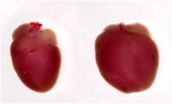(Press-News.org) DURHAM, N.H. – From an environmental perspective, Daphnia pulex -- the waterflea – is the best-studied organism on the planet. Scientists know how this species responds to pollution, predators, day and night, making it an important model for ecological and evolutionary research. Its genome, however, remained elusive, limiting understanding of how the environment and genes interact.
Until now. An international team of researchers comprising the Daphnia Genomics Consortium, including four from the University of New Hampshire's Hubbard Center for Genome Studies, has described the complete genome of Daphnia, opening the door to enhanced knowledge of this species and its response to its environment. And, despite the Daphnia's near-microscopic size, it contains more than 31,000 genes, more than any other animal with a complete gene sequence, including humans. The findings are detailed in an article in the journal Science this week.
"It's personally a major achievement," says W. Kelley Thomas, Hubbard Professor in Genomics and director of the HCGS, adding that the Daphnia sequence was among the center's original goals at its founding in 2001. "This genome gives biologists and ecologists the tools they need to do genomic analysis on this organism from an ecological perspective."
The end product is a better understanding of what genes matter for organisms to cope with environmental stresses like pollutants and global warming and of the technologies necessary to understand how these genes function within an animal that is easily studied in water reservoirs around the globe.
The study, "The Ecoresponsive Genome of Daphnia pulex," was led by researchers at Indiana University's Center for Genomics and Bioinformatics (CGB), Utah State University, the U.S. Department of Energy's Joint Genome Institute, and UNH's Hubbard Center. It found that the microscopic freshwater crustacean contains at least 30,907 genes, compared to approximately 25,000 in humans.
Scientists have studied Daphnia for centuries because of its importance in aquatic food webs and for its transformational responses to environmental stress. Predators signal some of the animals to produce exaggerated spines, neck-teeth or helmets in self-defense. And like the virgin nymph of Greek mythology that shares its name, Daphnia thrives in the absence of males -- by clonal reproduction, until harsh environmental conditions favor the benefits of sex.
Arguably, more is known about the ecology and stress biology of the water flea than any other animal. The genome project was conceived with an expectation that many new gene functions would be uncovered when studied in light of the animal's natural environment -- not necessarily expecting to discover many more genes.
Yet, Daphnia's genome is no ordinary genome.
"Daphnia's high gene number is largely because its genes are multiplying, by creating copies at a higher rate than other species," said project leader and CGB genomics director John Colbourne. "We estimate a rate that is three times greater than those of other invertebrates and 30 percent greater than that of human."
"One theory is that Daphnia is so good at adapting to so many environments because it has this huge catalog of genes to call upon," says Thomas. The researchers note that more than one-third of Daphnia's genes are undocumented in any other organism – they are completely new to science.
At UNH, where the relatively new field of environmental genomics is at the core of the HCGS mission, the Daphnia project resulted in productive collaborations around the university. "It was a significant part of starting many science careers," says Thomas, noting that many undergraduate, graduate and visiting students participated.
Jim Haney, professor of freshwater biology, helped with cultures of Daphnia, which are common in New Hampshire lakes and ponds. In addition, as the science of genome sequencing evolved in the past decade to use "fewer pipettes and more computers," says Thomas, the Hubbard Center forged strong bonds with UNH's computer science department, in particular professors Dan Bergeron and Phil Hatcher.
###
International collaboration has been essential to this project. Over the course of the project, the Daphnia Genomics Consortium has grown from a handful of founding members to over 450 investigators distributed around the globe. Nearly 200 scientists have contributed published work resulting from the genome study, many in open-source journals published as a thematic series by BioMedCentral. A list of these publications can be found at http://www.biomedcentral.com/series/Daphnia. Daphnia Genomics Consortium projects are featured at http://daphnia.cgb.indiana.edu. More information on this article is available at http://newsinfo.iu.edu/news/page/normal/17183.html.
This work received financial and material support from the Office of Science of the U.S. Department of Energy, the National Science Foundation, the Lilly Endowment, Inc., Roche NimbleGen Inc., the National Institutes of Health, the U.S. Department of Health and Human Services, and Indiana University.
The University of New Hampshire, founded in 1866, is a world-class public research university with the feel of a New England liberal arts college. A land, sea, and space-grant university, UNH is the state's flagship public institution, enrolling 12,200 undergraduate and 2,300 graduate students.
Photographs available to download:
http://www.unh.edu/news/cj_nr/2011/feb/Daphnia_Hebert.jpg
Daphnia minnehaha (commonly called waterflea) with mild defensive neckteeth against predators
Credit: Dr. Paul D.N. Hebert (University of Guelph), phebert@uoguelph.ca
http://www.unh.edu/news/cj_nr/2011/feb/Daphnia_Laforsch.jpg
Defensive neckteeth in juvenile Daphnia pulex (commonly called waterflea) in response to phantom midge predators
Credit: Dr. Christian Laforsch (Ludwig-Maximilians-Universität München), laforsch@zi.biologie.uni-muenchen.de
http://www.unh.edu/news/cj_nr/2011/feb/Daphnia_Michels.jpg
Daphnia pulex (commonly called waterflea)
Credit: Dr. Jan Michels (Christian-Albrechts-Universität zu Kiel), michels@zoologie.uni-kiel.de
END
Ms. K. is vision-impaired and can't get around very well any more. Still, the 80-year-old, who lives alone, has no intention whatsoever of moving to a retirement home. Most elderly people think the same way. They want to stay in their accustomed surroundings as long as possible, where they can lead an autonomous life. What many fail to realize is that they are risking their health in the process. Cardiovascular problems are more frequent among the elderly, and the risk of falling is more prevalent: one person in three above the age of 65 falls once a year; among those over ...
URBANA – A University of Illinois scientist reports that family mealtimes that contain three ingredients in the right amounts can improve the quality of life in children who have chronic asthma.
"Family mealtimes, when they're done right, are linked to many benefits for children, including a reduced risk of substance abuse, eating disorders, and obesity. In this study, we've put these mealtimes under a microscope so we can see minute by minute which factors deliver these healthy outcomes," said Barbara H. Fiese, director of the U of I's Family Resiliency Center.
Which ...
Rainer Kube and his working group report in the current issue of Deutsches Ärzteblatt International (Dtsch Arztebl Int 2011; 108[4]: 41-6) on new treatment strategies in patients with colon cancer.
The findings of multicenter observational studies are a good basis for improvements to overall quality of patient care. Against this background, from 2000 to 2004 Kube and his coauthors collected data on over 31 000 patients in 346 German hospitals. From this data pool they extracted statements about the quality of care. They discovered, for example, that colonoscopy screening ...
Compared to people in employment, men and women who are unemployed suffer more often and longer from both physical and emotional complaints. Why the un-employed should have health problems more often is discussed by Lars E. Kroll and his coauthor in the current issue of Deutsches Ärzteblatt International (Dtsch Arztebl Int 2011; 4: 47-52), along with a report on the findings of the GEDA study.
The GEDA study (Gesundheit in Deutschland Aktuell, or Current Health in Germany) was carried out in 2008-2009 by the Robert Koch Institute. The results showed that unemployed people ...
CHAPEL HILL, N.C. – Everyone knows chocolate is critical to a happy Valentine's Day. Now scientists are one step closer to knowing what makes a heart happy the rest of the year.
It's a gene called DOT1L, and if you don't have enough of the DOT1L enzyme, you could be at risk for some types of heart disease. These findings from a study led by researchers at the University of North Carolina at Chapel Hill School of Medicine appear in the Feb. 1, 2011 issue of the journal Genes and Development.
The team created a special line of mice that were genetically predisposed to ...
The first stars in the universe were not as solitary as previously thought. In fact, they could have formed alongside numerous companions when the gas disks that surrounded them broke up during formation, giving birth to sibling stars in the fragments. These are the findings of studies performed with the aid of computer simulations by researchers at Heidelberg University's Centre for Astronomy together with colleagues at the Max Planck Institute for Astrophysics in Garching and the University of Texas at Austin (USA). The group's findings, published in Science Express, ...
Things are not always what they seem when it comes to fish—something scientists at the Smithsonian Institution and the Ocean Science Foundation are finding out. Using modern genetic analysis, combined with traditional examination of morphology, the scientists discovered that what were once thought to be three species of blenny in the genus Starksia are actually 10 distinct species. The team's findings are published in the scientific journal ZooKeys, Feb. 3.
Starksia blennies, small (less than 2 inches) fish with elongated bodies, generally native to shallow to moderately ...
The vaccine for human papillomavirus (HPV) can prevent 90 percent of genital warts in men when offered before exposure to the four HPV strains covered by the vaccine, according to a new multi-center study led by H. Lee Moffitt Cancer Center and UCSF.
The four-year, international clinical trial, which also found a nearly 66 percent effectiveness in the general population of young men regardless of prior exposure to these strains, provides the first reported results of using the HPV vaccine as a prophylactic in men.
Initial data from this study informed the Food and Drug ...
NEW YORK (February 4, 2011) – Researchers at the NYU Child Study Center demonstrated that a brief program for families of Pre-Kindergarten students attending schools in disadvantaged urban communities improved children's behavior at school. The study, called "Promoting effective parenting practices and preventing child behavior problems in school among ethnically diverse families from underserved, urban communities," was published in the February 2011 issue of Child Development.
Dr. Laurie Miller Brotman and her colleagues spent several years developing ParentCorps, ...
Since the days of Darwin, the "tree of life" has been the preeminent metaphor for the process of evolution, reflecting the gradual branching and changing of individual species.
The discovery that a large cluster of genes appears to have jumped directly from one species of fungus to another, however, significantly strengthens the argument that a different metaphor, such as a mosaic, may be more appropriate.
"The fungi are telling us something important about evolution … something we didn't know," said Antonis Rokas, assistant professor of biological sciences at Vanderbilt. ...



